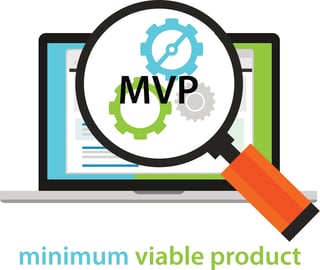Growth Insights for CEOs

Outsider Insights | From Hustle to System: Why More CEOs Are Rebuilding Their Sales Function
Outsider Insights
Across Chief Outsiders, we talk to hundreds of CEOs every month. In this new series, we explore the trends and challenges we’re hearing from these discussions – and what you can do if you’re facing the same issues in your business.
Recent Posts

Finding the Sweet Spot in B2B Markets
Fri, May 1, 2020 — Narrowing Focus to Drive Demand In a prior blog post, I discussed how a lack of market focus can lead to poor marketing campaign conversion rates.

Shooting Some Holes in the Minimum Viable Product
Thu, Apr 2, 2020 — With the right vision, appropriate resources, and more than a sprinkle of luck, a really good idea can quickly become a sensational success. When that happens, as late-night comedian John Oliver might say, such an idea becomes “a thing.” Unfortunately, when a good idea becomes “a thing” — like the product equivalent of John, Paul, George, and Ringo – the quality can suffer if too many producers try to put their imprint on the hit record. The idea can get watered down, generalized, and misused.

Five Major Indicators that Suggest a Need for Focus
Tue, Mar 3, 2020 — A Common Challenge for B2B technology, SaaS and Professional Services Businesses If market demand was a fixed commodity, attracting new business would require only that you create awareness and build interest around well-known needs. Companies who see their marketplace in this way often subscribe to a “lather, rinse, repeat,” approach to pipeline management – focusing marketing dollars on prospects already well-along their purchasing journey, identifying qualified opportunities, but paying little attention to the world of prospects who do not yet see their needs as urgent.
Stay up-to-date with the latest from Chief Outsiders

Can Your Business Thrive Despite Changes in the Economy? Part 2
Wed, Feb 26, 2020 — Time to Hide or Double Down? Riding the 2020 Wave Establishing order in the midst of chaos can be most elusive, wouldn’t you agree? Just ask poor Chip Diller, the do-gooder ROTC cadet portrayed by Kevin Bacon in the seminal college movie classic, “Animal House.” Surrounded by fleeing masses in a parade gone wrong, and about to be bulldozed by a stampeding crowd, Diller thrusts out his hands and, gathering as much gravitas as possible, shouts, “Remain calm. All is well!” before he’s swarmed by the crowd and trampled into a facsimile of “Flat Stanley.”

Think Different and GROW: Delight Your Way to Accelerated Success
Wed, Feb 12, 2020 — One of the most influential Apple commercials ever made continues to resonate with me, nearly a quarter century after it was first released. Adorned with the tagline, “Think Different,” the Richard Dreyfus-narrated spot celebrated how non-conformist inventors pushed, annoyed and irritated the established order to change the world. The commercial underscored the convention-breaking culture at Apple – and, as they say, the rest is history. While many saw the Apple commercial as a call to a particular type of idealism, in today’s society, the message “Think Different” has a very practical purpose that can be applicable to the most routine of businesses today. Creating growth in your business in today’s marketplace means doing something different enough to put the business on a faster trajectory. So how can you, and your team, think different as a means of accelerating success?

Can Your Business Thrive Despite Changes in the Economy?
Wed, Jan 29, 2020 — Part 1: How Good are your Insights: Are you Guilty of Confirmation Bias? How do most business owners make decisions? If you answered, a) by reading the tea leaves; b) by the seat of their pants; c) through instinct and innuendo; or d) by flipping a coin, you may want to make an appointment with a good psychiatrist – and perhaps consider another line of work. In all seriousness, when I ask business owners about the foundation for their optimism about the economy, the answers often include sources such as cable news, blogs, websites, the Wall Street Journal, and sometimes even Google searches about the “state of the economy.”

Diversity Drives Innovation, Growth and the Bottom Line
Tue, Oct 22, 2019 — By Yvonne Brown and Tom McCrary Diversity is increasingly on our minds. Indeed, US census data indicates that our population is becoming more diverse, estimating that by 2042, whites will no longer be a majority of the population. An important business corollary—and a significant opportunity—is that diversity in an organization drives innovation, growth and bottom-line improvement.

Finding ‘Grand Slam’ Clients Using an Ideal Client Profile to Build Your Business
Mon, Oct 14, 2019 — A Practical Implementation Guide for Small- and Mid-Sized Business Executives Mark Coronna, Area Managing Partner & CMO, Chief Outsiders with Todd Eberhardt, CEO, Dynasty Leadership Consulting Somewhere in the historical development of Marketing language the concept of an Ideal Customer Profile emerged. You can find frequent discussion of this concept if you are reading marketing blogs today—it is definitely a “buzz” term, and legitimately so, if you understand the power of the concept and apply it to your customer acquisition programs. We’d like to discuss how to practically implement the concept of an Ideal Customer Profile and talk about why it’s important, as well as how it can dramatically impact your business, when applied to your Marketing and Sales programs.

Why a “Failure to Communicate” is a First Step to Going Out of Business
Wed, Sep 25, 2019 — What Business Execs Can Learn About the Power of Authentic Conversations Mark Coronna, Area Managing Partner & CMO, Chief Outsiders with Matt McKnight, President, McKnight Advisors If you’ve ever seen the Paul Newman movie Cool Hand Luke, you might remember the hard-boiled egg eating contest, but that’s another subject. The iconic line we all remember, after several failed attempts to bring Luke in line, is when the prison warden remarks, “What we have here is a failure to communicate.” Knowledge, open communications, as well as procrastination are highly linked to business performance. Having hands-on and personal real-time knowledge of what’s going on in your business is a challenge and having the confidence and willingness to do something about what you’ve learned is another.
.png?width=1500&height=398&name=CO_Corporate%20Logo%202021_4C_HOR_FNL-1%20(1).png)